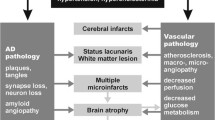Abstract.
Study of the hippocampal formation of 82 subjects, including 25 control subjects from 33 to 83 years of age, 34 subjects with Alzheimer disease (AD) from 65 to 89 years of age, and 23 subjects with Down syndrome (DS) from 33 to 72 years of age, revealed hippocampal vasculopathy with fibrosis and calcification (VFC) in 40% of control, 59% of AD, and 4% of DS subjects. VFC starts in the precapillaries/capillaries in the molecular layer of the dentate gyrus (DG) and expands to the granule cell and polymorphic cell layer of the DG, and to the stratum lacunosum/moleculare in the CA1 sector. Vasculopathy spreads from the tail to the body and, in a few cases, to the head of the hippocampal formation. Light and electron microscopy reveal thickening of the vascular wall with fibrosis, calcification, and enforcement of the astrocyte interface with vessels with anchorage densities associated with hemidesmosome-like structures. In moderately and severely affected cases, fragmentation and removal of calcified and occluded vessels result in local reduction of vascular network. In two AD subjects, severe vascular calcification extending from the tail to the head of the hippocampal formation was associated with loss of almost all neurons in the CA1 sector and in the subiculum proper, corresponding to hippocampal sclerosis. The topography of affected vessels and the patterns of neuronal loss reflect the middle hippocampal artery distribution with its precapillary/capillary network. The similar prevalence of vasculopathy in the AD group and in the age-matched control group, and the presence of hippocampal VFC in only one subject in the DS cohort, 96% of which is affected by Alzheimer-type pathology, oppose the link between AD and this form of vasculopathy. However, severe VFC affects the pattern of AD pathology locally by deletion of neurofibrillary degeneration and β-amyloidosis in the CA1 sector, subiculum proper, and the molecular layer of the dentate gyrus. Hippocampal VFC appears to be a form of vascular pathology with a unique predilection for the middle hippocampal artery and corresponding capillary network, which results in patchy neuronal loss in moderately affected subjects and in almost total neuronal loss in the area of impaired blood supply in severely affected subjects. These observations suggest an etiologic link between hippocampal VFC and hippocampal sclerosis.
Similar content being viewed by others
Author information
Authors and Affiliations
Additional information
Electronic Publication
Rights and permissions
About this article
Cite this article
Wegiel, .J., Kuchna, .I., Wisniewski, .T. et al. Vascular fibrosis and calcification in the hippocampus in aging, Alzheimer disease, and Down syndrome. Acta Neuropathol 103, 333–343 (2002). https://doi.org/10.1007/s00401-001-0471-y
Received:
Revised:
Accepted:
Issue Date:
DOI: https://doi.org/10.1007/s00401-001-0471-y




